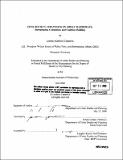| dc.contributor.advisor | JoAnn Carmin. | en_US |
| dc.contributor.author | Campbell, Lindsay Kathleen | en_US |
| dc.contributor.other | Massachusetts Institute of Technology. Dept. of Urban Studies and Planning. | en_US |
| dc.date.accessioned | 2007-06-28T12:17:08Z | |
| dc.date.available | 2007-06-28T12:17:08Z | |
| dc.date.issued | 2006 | en_US |
| dc.identifier.uri | http://hdl.handle.net/1721.1/37658 | |
| dc.description | Thesis (M.C.P.)--Massachusetts Institute of Technology, Dept. of Urban Studies and Planning, 2006. | en_US |
| dc.description | "June 2006." | en_US |
| dc.description | Includes bibliographical references (p. 157-169). | en_US |
| dc.description.abstract | Urban, industrial waterways-with their contamination, environmental injustice, and nebulous development futures given changing economies-present multiple problems that are confronted by environmental civil society organizations. Despite the many problems, these groups view urban waterways as some of the last available open space in the city and as potential public amenities and natural resources that merit revitalization. This work focuses on the means by which citizen groups and nonprofit organizations-which are often in positions of relatively less power and authority vis-h-vis public and private actors-attempt to engage, be heard, and leverage influence over decision-making on and end use of three New York City river resources. Depending on the situation and the groups involved, strategies rooted in conflict or collaboration rise to the fore. Civil society organizations select from "insider" strategies based on cooperation with government, "outsider" strategies that depend upon advocacy and pressure tactics directed towards either government or the private sector, and "independent" strategies like stewardship, education, and environmental monitoring that engage with the resource, regardless of the political and policy context. | en_US |
| dc.description.abstract | (cont.) To understand the selection and efficacy of strategies in general and alliance-building in specific, this thesis examines the following questions: 1) how do internal and external factors shape the strategies that civil society actors select as they seek to engage in the protection of urban industrial waterways?; 2) to what extent and for what reasons are civil society actors pursuing collaboration and coalition building as a preferred strategy? and 3) what environmental and social outcomes are achieved as a consequence of different strategic approaches? To address these questions I conducted case studies of the Bronx River, the Newtown Creek, and the Gowanus Canal. As a comparative study, tis thesis reveals that the complex challenges of restoration in the urban environment require equally complex solutions. There is no one single, prescriptive approach that will yield more successful environmental and social outcomes. Strategies are products of resource constraints, political opportunities, community contexts, and deeply embedded group ideologies. While groups have a dominant strategy, they can shift and evolve over time in response to different triggers. | en_US |
| dc.description.abstract | (cont.) For all of the benefits of this pluralism, cooperation is the strategy that can serve to bring the most resources to bear for long term planning and revitalization. Coalition building requires divergent ideologies to be aligned and find common ground, and it is a deliberate process that requires entrepreneurial leadership by both citizens and public servants. | en_US |
| dc.description.statementofresponsibility | by Lindsay Kathleen Campbell. | en_US |
| dc.format.extent | 169 p. | en_US |
| dc.language.iso | eng | en_US |
| dc.publisher | Massachusetts Institute of Technology | en_US |
| dc.rights | M.I.T. theses are protected by copyright. They may be viewed from this source for any purpose, but reproduction or distribution in any format is prohibited without written permission. See provided URL for inquiries about permission. | en_US |
| dc.rights.uri | http://dspace.mit.edu/handle/1721.1/7582 | |
| dc.subject | Urban Studies and Planning. | en_US |
| dc.title | Civil society strategies on urban waterways : stewardship, contention, and coalition building | en_US |
| dc.type | Thesis | en_US |
| dc.description.degree | M.C.P. | en_US |
| dc.contributor.department | Massachusetts Institute of Technology. Department of Urban Studies and Planning | |
| dc.identifier.oclc | 123897214 | en_US |
